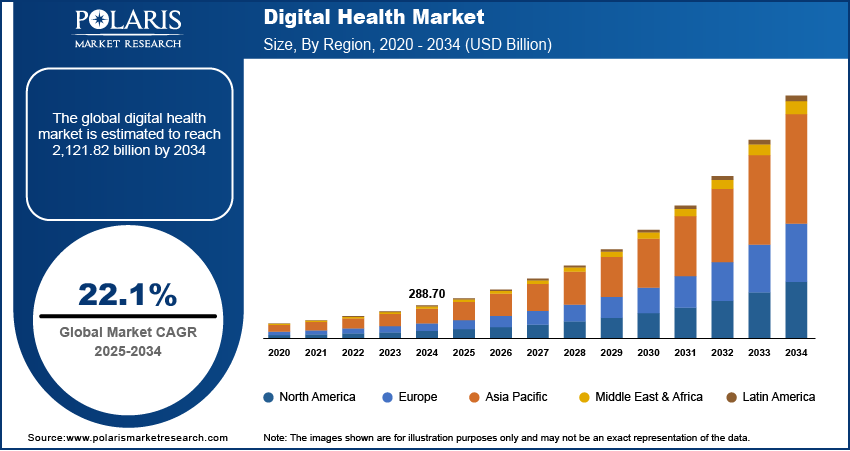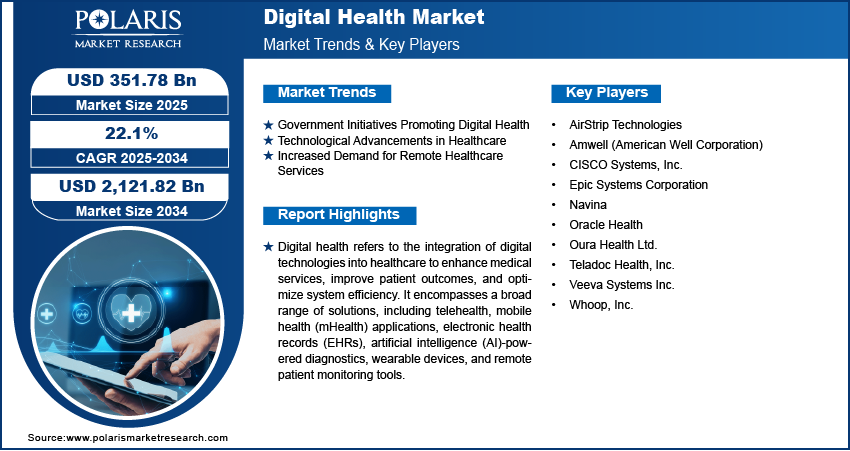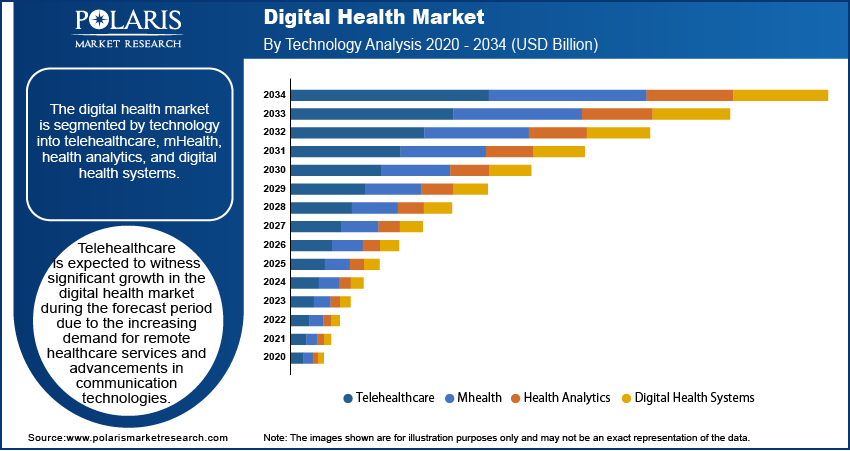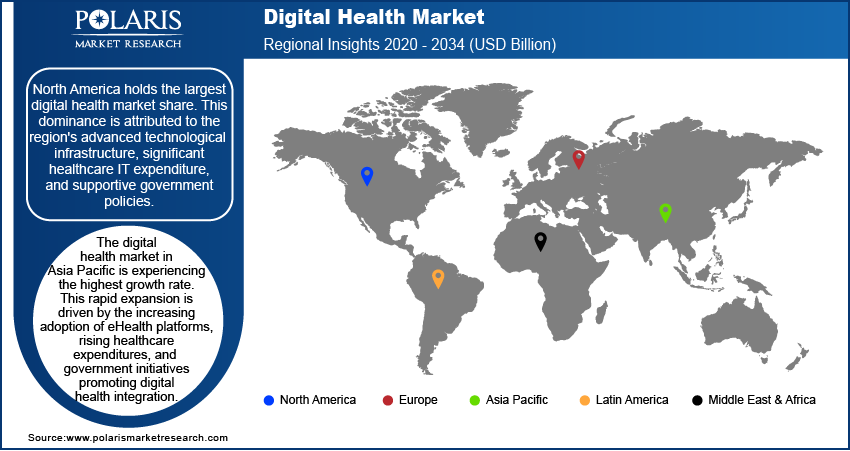
Digital Health Market Size, Share, Trends, Industry Analysis Report
By Technology (Telehealthcare, mHealth, Health Analytics, Digital Health Systems), By Component, By Application, By Region – Market Forecast, 2025–2034
- Published Date:Sep-2025
- Pages: 112
- Format: PDF
- Report ID: PM1375
- Base Year: 2024
- Historical Data: 2020-2023
Market Overview
The digital health market size was valued at USD 288.70 billion in 2024 and is expected to register the highest CAGR of 22.1% during 2025–2034. The increasing prevalence of chronic diseases and rising elderly population globally propel the need for remote healthcare solutions. The rising adoption of smartphones and connected devices fuels the demand for mobile health applications and wearable technology. These factors boost the digital health market growth.
Key Insights
- The telehealthcare segment is expected to witness significant growth during the forecast period. This segment growth is attributed to the increasing demand for remote healthcare services and advancements in communication technologies.
- The services segment held the largest market share in 2024. This dominance is attributed to the increasing adoption of teleconsultation services, which offer accessible healthcare solutions.
- North America held the largest market share in 2024. This dominance is driven by the region's advanced technological infrastructure and significant healthcare IT expenditure.
- The Asia Pacific industry is experiencing the fastest growth. The rising adoption of eHealth platforms and rising healthcare expenditures boost the industry expansion.
Industry Dynamics
- Government initiatives to improve healthcare delivery are fueling the market growth.
- The rising demand for remote healthcare services, driven by the rising need for accessible healthcare, contributes to industry development.
- Rapid technological advancements, such as mobile connectivity, cloud computing, big data analytics, and artificial intelligence, in digital health solutions will provide opportunities for the market during the forecast period.
- Rising concerns regarding data privacy and cybersecurity hinder the industry expansion.
Market Statistics
2024 Market Size: USD 288.70 billion
2034 Projected Market Size: USD 2,121.82 billion
CAGR (2025–2034): 22.1%
North America: Largest market in 2024
AI Impact on Digital Health Market
- Artificial intelligence (AI) is revolutionizing the digital health landscape by personalizing care and streamlining operations across the healthcare ecosystem.
- The technology automates patient intake and treatment planning, which improves the speed and accuracy of patient treatments.
- AI integrates data from genomics, wearables, and smartphone apps to customize treatments for individuals.
- AI-powered platforms have multilingual capabilities, which break language barriers in telehealth services. Chatbots and virtual assistants answer health queries.

To Understand More About this Research:Request a Free Sample Report
The digital health market encompasses a broad range of technologies designed to improve healthcare delivery, improve patient outcomes, and streamline medical processes. It includes telemedicine, mobile health applications, wearable devices, electronic health records, and artificial intelligence-driven diagnostics. The market has seen substantial growth due to increasing reliance on digital solutions for healthcare services. Digital health has become an essential component of modern medical practices with the rising demand for remote patient monitoring devices and virtual consultations. The integration of advanced technologies is improving how healthcare providers interact with patients, ensuring timely and efficient care delivery.
The increasing prevalence of chronic diseases, coupled with the growing elderly population, has heightened the need for remote healthcare solutions. Additionally, government initiatives promoting digital health adoption and improved internet accessibility have further accelerated digital health market growth. The rising use of smartphones and connected devices has fueled the demand for mobile health applications and wearable technology. Furthermore, advancements in artificial intelligence and data analytics are improving diagnosis accuracy and personalized treatment plans. These factors, combined with a shift toward patient-centric care, are expected to drive the market positively in the coming years.
Market Dynamics
Government Initiatives Promoting Digital Health
Government initiatives have been instrumental in accelerating the adoption of digital health technologies. Governments are aiming to improve healthcare delivery, enhance patient outcomes, and reduce costs by implementing policies and programs that support the integration of digital solutions into healthcare systems. For instance, the Ayushman Bharat Digital Mission (ABDM), launched by the Government of India, seeks to develop the backbone necessary for the integrated digital health infrastructure of the country. This initiative aims to bridge the existing gap among different stakeholders in the healthcare ecosystem through digital highways, thereby promoting prompt and structured healthcare across the nation. The ABDM supports universal health coverage in an efficient, accessible, inclusive, affordable, timely, and safe manner by creating a national digital health ecosystem. Such government-led initiatives are pivotal in driving the growth of the digital health adoption, driving the digital health market growth.
Technological Advancements in Healthcare
Rapid technological advancements have substantially contributed to the expansion of digital health platforms. Innovations in mobile connectivity, cloud computing, big data analytics, and artificial intelligence have enabled the development of advanced digital health solutions. These technologies facilitate telemedicine, wearable devices, and mobile health applications, allowing for remote patient monitoring and personalized healthcare. A study published in 2023 highlights how the integration of Internet of Things (IoT)-assisted wearable sensor devices and AI is shifting healthcare from a conventional hub-based system to a more personalized healthcare management system. This shift has improved patient engagement and enabled proactive health management, thereby driving the digital health market demand
Increased Demand for Remote Healthcare Services
The demand for remote healthcare services is growing, driven by factors such as the increasing prevalence of chronic diseases, an aging population, and the need for accessible healthcare. Frequent hospital visits and doctor consultations for the elderly population are difficult, specifically in rural areas where healthcare services are limited, due to which the demand for remote healthcare services is growing. Digital health technologies address the growing need for remote healthcare services by enabling continuous patient monitoring and virtual consultations, thereby propelling the market expansion.

Segment Insights
Market Assessment by Technology
The digital health market segmentation, based on technology, includes telehealthcare, mhealth, health analytics, and digital health systems. The telehealthcare is expected to witness significant market growth during the forecast period. This segment's prominence is attributed to several factors, including the increasing demand for remote healthcare services and advancements in communication technologies. Government initiatives and policies promoting digital health have further boosted this segment's growth in the market.
Market Evaluation by Component
The digital health market is segmented by component into hardware, software, and services. The services segment holds the largest digital health market share. This dominance is primarily due to the increasing adoption of teleconsultation services, which offer cost-effective and accessible healthcare solutions. The expansion of companies providing such services has further propelled this segment's growth. Additionally, the rising prevalence of chronic diseases and the growing demand for remote patient monitoring have contributed to the expansion of the services segment, solidifying its leading position in the market.

Regional Insights
By region, the study provides the digital health market insights into North America, Europe, Asia Pacific, Latin America, and the Middle East & Africa. North America holds the largest market share. This dominance is attributed to the region's advanced technological infrastructure, significant healthcare IT expenditure, and supportive government policies. The US, in particular, has seen substantial investments in digital health technologies, fostering the development and adoption of telemedicine, electronic health records, and mobile health applications. Government initiatives have further accelerated the adoption of digital health platforms, driving the growth of market in North America.
The digital health market in Asia Pacific is experiencing the fastest growth rate. This rapid expansion is driven by the increasing adoption of eHealth platforms, rising healthcare expenditures, and government initiatives promoting digital health integration. Countries such as India and China are at the forefront of this growth. In India, initiatives such as the Digital India program and the establishment of a national health authority are enhancing the digital health ecosystem. Similarly, China's emphasis on health information technology and telemedicine services is transforming its healthcare landscape. These developments are propelling Asia Pacific’s prominence in the market.

Key Players and Competitive Insights
The digital health market features several prominent companies actively offering a range of products and services. Key players include Teladoc Health, Inc.; Epic Systems Corporation; Amwell (American Well Corporation); Veeva Systems Inc.; Oura Health Ltd. Whoop, Inc.; Oracle Health (a division of Oracle Corporation); AirStrip Technologies; and CISCO Systems, Inc.
The competitive landscape of the digital health market is characterized by rapid technological advancements and strategic partnerships. Companies are focusing on expanding their product portfolios through innovation and acquisitions to meet the growing demand for digital health solutions. For instance, in 2022, Oracle Corporation acquired Cerner Corporation, integrating its health information technologies into Oracle's broader suite of services. These strategic moves reflect the dynamic nature of the market and the emphasis on consolidating capabilities to provide comprehensive digital health solutions.
Teladoc Health Inc., headquartered in Purchase, New York, offers virtual healthcare services, including telehealth, medical opinions, AI and analytics, and telehealth devices. Its platform enables on-demand remote medical care through telephone and videoconferencing software, addressing a wide range of healthcare needs across more than 130 countries. Teladoc Health's services are integral to the digital health market, providing accessible and efficient healthcare solutions globally.
Epic Systems Corporation, based in Verona, Wisconsin specializes in healthcare software, particularly electronic health records (EHR). Its software is utilized by numerous hospitals and healthcare organizations, managing medical records for a significant portion of patients in the US and internationally. Epic's contributions are central to the digital health market, facilitating the digitalization and interoperability of patient health information.
List of Key Companies
- AirStrip Technologies
- Amwell (American Well Corporation)
- CISCO Systems, Inc.
- Epic Systems Corporation
- Navina
- Oracle Health
- Oura Health Ltd.
- Teladoc Health, Inc.
- Veeva Systems Inc.
- Whoop, Inc.
Digital Health Industry Developments
- December 2024: New Enterprise Associates (NEA) announced plans to acquire NeuHealth, Inc., a healthcare technology company specializing in digital health services such as artificial intelligence, telemedicine, and data analytics. The all-cash transaction, valued at USD 1.3 billion, aims to provide
- February 2024: JD Health launched a dedicated elderly care channel on its app, offering a comprehensive platform to address the diverse healthcare needs of China's aging population.
Digital Health Market Segmentation
By Technology Outlook (Revenue-USD Billion, 2020–2034)
- Telehealthcare
- Mhealth
- Health Analytics
- Digital Health Systems
By Component Outlook (Revenue-USD Billion, 2020–2034)
- Hardware
- Software
- Services
By Application Outlook (Revenue-USD Billion, 2020–2034)
- Cardiology
- Diabetes
- Neurology
- Sleep Apnea
- Oncology
- Others
By Regional Outlook (Revenue-USD Billion, 2020–2034)
- North America
- US
- Canada
- Europe
- Germany
- France
- UK
- Italy
- Spain
- Netherlands
- Russia
- Rest f Europe
- Asia Pacific
- China
- Japan
- India
- Malaysia
- Suth Korea
- Indnesia
- Australia
- Vietnam
- Rest f Asia Pacific
- Middle East & Africa
- Saudi Arabia
- UAE
- Israel
- Suth Africa
- Rest f Middle East & Africa
- Latin America
- Mexic
- Brazil
- Argentina
- Rest f Latin America
Digital Health Market Report Scope
|
Report Attributes |
Details |
|
Market Size Value in 2024 |
USD 288.70 billion |
|
Market Size Value in 2025 |
USD 351.78 billion |
|
Revenue Forecast by 2034 |
USD 2,121.82 billion |
|
CAGR |
22.1% from 2025 to 2034 |
|
Base Year |
2024 |
|
Historical Data |
2020–2023 |
|
Forecast Period |
2025–2034 |
|
Quantitative Units |
Revenue in USD billion and CAGR from 2025 to 2034 |
|
Report Coverage |
Revenue Forecast, Market Competitive Landscape, Growth Factors, and Industry Insights |
|
Segments Covered |
|
|
Regional Scope |
|
|
Competitive Landscape |
|
|
Report Format |
|
|
Customization |
Report customization as per your requirements with respect to countries, regions, and segmentation. |
How is Report Valuable for Organization?
Workflow/Innovation Strategy: The digital health market has been segmented into detailed segments of technology, component, and application. Moreover, the study provides the reader with a detailed understanding of the different segments at both the global and regional levels.
Growth/Marketing Strategy: The growth and marketing strategy of the digital health market revolves around technological innovation, strategic partnerships, and expanding digital healthcare accessibility. Companies are leveraging artificial intelligence, telemedicine, and mobile health applications to enhance patient engagement and streamline healthcare delivery. Strategic collaborations with healthcare providers, insurers, and tech firms are driving market expansion, while regulatory support and government initiatives are further accelerating adoption. Additionally, targeted marketing campaigns focusing on data-driven insights, user-friendly platforms, and personalized healthcare experiences are strengthening consumer trust and engagement. These strategies collectively contribute to the sustained growth of the market.
FAQ's
The digital health market size was valued at USD 288.70 billion in 2024 and is projected to grow to USD 2,121.82 billion by 2034.
The market is projected to register a CAGR of 22.1% during the forecast period, 2025-2034.
North America had the largest share of the market.
Key players in the digital health market include Teladoc Health, Inc.; Epic Systems Corporation; Amwell (American Well Corporation); Veeva Systems Inc.; Oura Health Ltd. Whoop, Inc.; Oracle Health (a division of Oracle Corporation); AirStrip Technologies; and CISCO Systems, Inc.
The services segment accounted for the larger share of the market in 2024.
Digital health refers to the use of technology to improve healthcare delivery, patient outcomes, and overall medical system efficiency.
